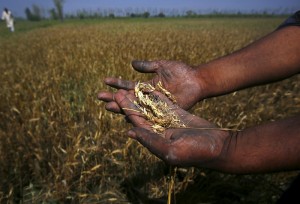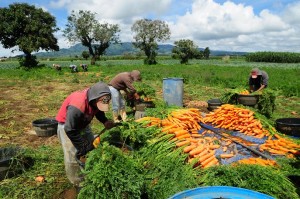Revitalizing the Agriculture Sector of Pakistan
Despite being neglected over the decades, the agriculture sector remains the backbone of Pakistan’s economy. It is still the largest sector of the economy of Pakistan in terms of labour participation, and as such livelihood of the majority of the population directly or indirectly depends on it. This sector employs approximately 40% of the country’s total labour force, provides income to 64% rural population, and contributes 19.3% to GDP (Pakistan Economic Survey 2019-20). It has been a major consumer of industrial goods that are manufactured locally, i.e. tractors, pesticides and fertilisers. Apart from this, it also ensures the supply of essential raw material to the export-oriented industries which in turn, enables the country to export goods abroad and earn valuable foreign exchange. Therefore, it can be said that revitalizing, restructuring and reorienting agro-based economy is sine qua non for a progressive, prosperous and developed Pakistan.
But, decades of inconsistent, uncoordinated and untargeted policies adopted by successive governments towards the agriculture sector have exacerbated the economic woes facing this country. It is remarkable to note that agricultural productivity has been declining, causing challenges of food security and subsequently, adversely impacting economic growth. According to UNDP forecasts, Pakistan’s demographic profile will dramatically change by 2050 which means around 200 million additional people will have to be taken care of. Worryingly, at present, some 21 million Pakistanis are grappling with worrisome food insecurity.
What makes the situation more complex is the unprecedented monsoon rains in August this year that apparently, dealt a serious blow to the small- and medium-sized land-owners particularly, in Sindh province. It is reported that all major crops that were at the harvesting phase, including cotton, sugarcane, onion, vegetables, and tomato, have been damaged. Agricultural experts have also warned that massive destruction of agriculture production due to both heavy spells of rain and locust swarms have posed a formidable threat to food security in Pakistan.
However, the inability and failure of the authorities to encourage farm modernization, facilitate the supply of agricultural technological equipment, build an efficient irrigation network and promote research and development (R&D) have been the key factors responsible for the declining per-acre yield over the years.
Because of this, the farmers have been unable to invest their financial and economic resources in value-added crops that include edible oils, vegetables and fruits that have the potential to raise their incomes exponentially. Nevertheless, despite being the 5th largest milk-producer country along with hosting a huge cattle population, a large chunk of Pakistan’s population finds it unaffordable to consume milk and meat which signifies weaknesses and vulnerabilities of the country’s livestock sector.
The impediments
- Conventional methods of farming
Impoverished farmers owning small land-holdings tend to apply traditional methods of cultivation and farming practices in their farms as they find it difficult to invest in modern methods and innovative technologies. It has been observed that poverty, lack of awareness about modern techniques and subsistence farming—where farm output is grown to fulfil only family’s needs with no surplus for sale—have forced farmers to abstain from putting in place advanced farming activities.
Additionally, the dismal economic conditions of farmers also restrict their ability to use fertilisers—essential elements for plant nutrition. These, collectively, bring about depletion in the overall land productivity and per-hectare yield. Recently, locust attack posed an unprecedented challenge to the agricultural production. Although this challenge was effectively overcome by many other developing nations by methods like using unmanned aerial vehicles, Pakistan couldn’t do much as its agriculture sector is ill-equipped in terms of technology.
- Inequitable water supplies and inefficient irrigation system
Water is one of the essential inputs in agriculture. Pakistan’s weakening agro-based economy confronts imbalanced water distributions in watercourse together with unreliable water supplies to the arable land which has led to a substantial decline in crop yields across the country.
Importantly, Pakistan hosts one of the biggest irrigation networks, but, owing to inefficiencies and irregularities such as seepage, leakage and unlined canals, 60% of the water gets wasted. As per the United Nations Food and Agriculture Organization (FAO), Pakistan is likely to be the most water-stressed country in the Asian region by 2040. This will certainly create a great scarcity of surface water required for irrigation and industry.
- Absence of robust credit facilities
An inadequate credit policy framework associated with a high-interest rate and untimely supply of loans curtail the potential of farmers to invest in farms, ensure the enhancement of land’s fertility, adopt mechanized farming techniques, and buying qualitative agricultural inputs. Resultantly, farmers end up getting low crop yield and agricultural productivity.
- Lack of investment in R&D
Lack of investment in agricultural R&D has made it almost impossible for the concerned authorities to allow farmers to, inter alia, embrace new seed varieties, use better water-utilization methods and innovative technologies such as sprinkler, bed planting, zero tillage, laser land levelling, and leaching. Unfortunately, the negligence of the executive-cum-legislative branch of the state can be gauged from the fact that the allocation of financial resources to R&D remained from 0.11 to 0.63 percent of agricultural GDP over the last two decades.
- Dearth of technical and vocational education
What is more troubling is the incompetence of the administrative hierarchy to organize technical and vocational training programmes related to teaching advanced techniques to farmers so that they can use much-needed knowledge and experience for the betterment of soil, crops and land productivity. The key stakeholders of the agricultural sector are the Ministry of National Food Security & Research and provincial agriculture departments that have been driven by incompetent officialdom, putting in place no meaningful reforms to revamp the agriculture economy.
- Inadequate seed production
The insufficient seed-producing volume doesn’t commensurate with the ever-rising needs of the cultivable land, owing to a series of financial, infrastructural and human resource constraints. Although public and private sectors have been investing greatly to produce seeds to bridge the demand and supply gap, quality and quantity produced have failed to raise the agricultural production.
Strategies to revitalize
- Use of modern technology and farmer training programmes
In an attempt to improve land productivity, modern technology and advanced technological equipment needs to be utilized and put in place by farmers. The incumbent PTI government and provincial authorities have to ensure a timely supply of equipment and tools, followed by robust, vibrant and effective farming education in rural areas of the country.
Easy access to micro-finance resources, financial incentives and technical support can help attain the objective of reinvigorating the agricultural sector. To add, awareness campaigns regarding high-yielding seeds, advanced irrigation and modern cultivation technologies can contribute as well. Farmers must be trained to use solar-powered, high-efficiency irrigation methods, drones—required for aerial mapping, weed detection, and soil analysis—and smart water grids to uptick agricultural production. This will allow farmers to be efficient and profitable, as well as environment-friendly.
According to a World Economic Forum report, the Netherlands has become the world’s second largest food exporter while curtailing the use of water by almost 90% and eliminating the use of insecticides and pesticides. Surprisingly, drones are used to monitor fields of potato and onion, helping the Dutch to produce crop yield more than double the global average. China, India and Brazil are following the same path carved by the Netherlands. Pakistan can learn from the success of these countries.
- Expanding agricultural credit facilities
Farmers need financial resources to invest in improved fertilisers, new seed varieties, and updated irrigation technologies. Expanding the outreach of the banking sector to rural areas will allow farmers to have adequate access to loans that will be pivotal to the acceleration of agricultural production. In this critical facility, public-private partnership (PPP) can be instrumental in boosting up the process of granting loans to the farmers.
Recently, the federal government offered Rs 50 billion to enable farmers to access cheaper cottonseed, pesticides, fertilisers and tractors, and most importantly, bank loans. This package is aimed at improving the deteriorating socio-economic condition of the farmers in the wake of the Covid-19 pandemic. Although this is a welcome development, yet more is required immediately and urgently.
Land reforms are one of the significant strategies Pakistan can implement to revamp the agriculture sector. Large as well as small landholdings have proved to be unproductive and ineffective. These impediments can be removed with the help of determining productive farm size that should be implementable across the country. This will certainly force tenants and cultivators to invest in the enhancement of land productivity, leading to improvement in their lifestyles and ultimately, assuming upward social mobility. For that, the Parliament will have to build consensus among all the stakeholders for effective and pragmatic legislation related to land reforms.
Considering the intense shortage of water, containing agricultural output, Pakistan needs to design robust policies to increase the storage capacity of existing dams, building new dams and constructing an efficient irrigation network. This demands an urgent attention of the policymakers as the availability of sufficient water on a sustainable basis is indispensable to the country’s economic development.
- Increasing agricultural resilience, and support price policies
To ensure sustainable, long-lasting and enduring economic growth, Pakistan must build up its agricultural resilience by protecting this sector from extreme climatic and weather conditions such as floods, droughts and diseases and pests. This can be done by channeling public funding into comprehensive and corroborative agricultural research, agricultural inputs and seed systems, as well as soil and fertility management.
On the other hand, farmers often complain about lower prices of their crops, leading to a greater degree of de-motivation and discouragement among them to invest heavily in farms. For that, the government has to ensure the proper application of price policy that can encourage farmers to increase output.
- Adapting to urbanization
As huge rural-urban migration results in expanding urban centres in Pakistan, the demand for perishable items, i.e. vegetables, fruits, dairy products and meat, is increasing exponentially. The government should offer lucrative incentives to farmers to invest in these items by building the infrastructural network and better transportation. This way, a timely supply of essential items can be realized.
- Development of agro-industrial cluster
The development of an agro-industrial cluster can generate more than US$19 billion additional revenue for Pakistan, if the private sector begins investing in it. Gone are the days when subsidies were offered to the farmers by the governments to reduce their cost of production. Now, the market-driven approach along with problem-solving research, commercialized farming and construction of rural infrastructure can transform the agriculture sector as witnessed by other countries.
Conclusion
Without eliminating chronic poverty that is prevailing especially in the countryside, Pakistan cannot attain economic progress. And poverty cannot be wiped out without strengthening the agriculture sector. But the problem is that inhabitants of rural areas, whose only business is agriculture, are poor. So, when Pakistan makes efforts to improve agriculture, it means it is making efforts to improve economic standing of the rural people which make around 64% of country’s population. This way, the country can get rid of poverty, enabling farmers to improve their lives and livelihoods, and to produce more, feed more, and significantly, export more. Policy-makers need to understand this cycle. Rome wasn’t built in a day!
 Jahangir's World Times First Comprehensive Magazine for students/teachers of competitive exams and general readers as well.
Jahangir's World Times First Comprehensive Magazine for students/teachers of competitive exams and general readers as well.





